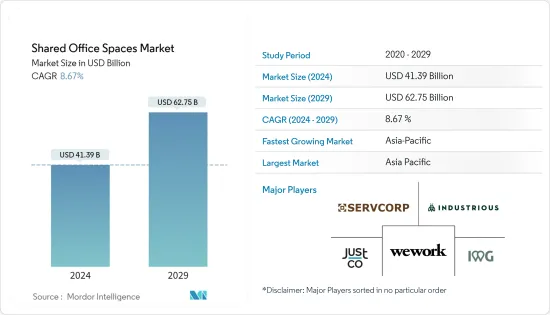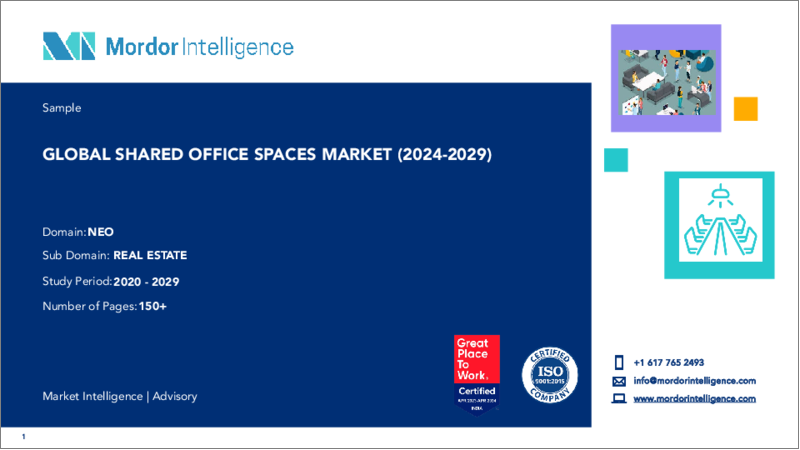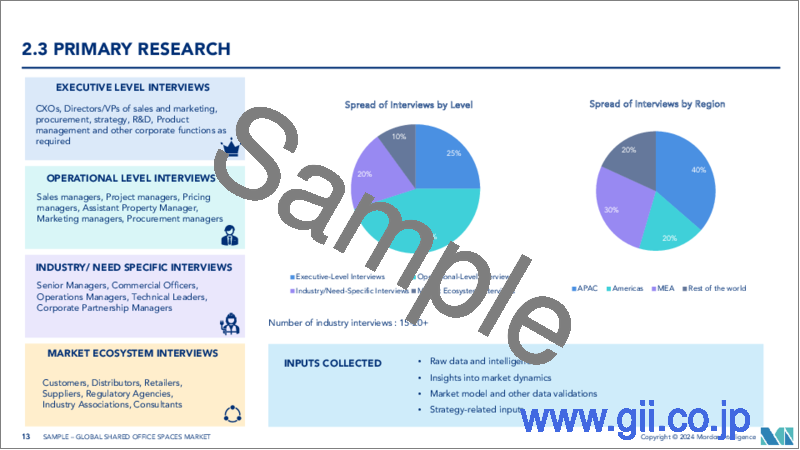|
|
市場調査レポート
商品コード
1440323
シェアオフィススペース:市場シェア分析、業界動向と統計、成長予測(2024~2029年)Shared Office Spaces - Market Share Analysis, Industry Trends & Statistics, Growth Forecasts (2024 - 2029) |
||||||
カスタマイズ可能
適宜更新あり
|
|||||||
| シェアオフィススペース:市場シェア分析、業界動向と統計、成長予測(2024~2029年) |
|
出版日: 2024年02月15日
発行: Mordor Intelligence
ページ情報: 英文 150 Pages
納期: 2~3営業日
|
全表示
- 概要
- 目次
シェアオフィススペース市場規模は、2024年に413億9,000万米ドルと推定され、2029年までに627億5,000万米ドルに達すると予測されており、予測期間(2024年から2029年)中に8.67%のCAGRで成長します。

主なハイライト
- パンデミック時代のリモートワークブームは、従業員をオフィスに戻そうと雇用主があらゆる種類のなだめたり、なだめたり、脅迫したにもかかわらず、基本的にはそのまま残っています。かつては賑わっていた商業ビルを利用する従業員が減り、どこからでも働けるダイナミックな動きは従来のオフィス部門にとって不健全です。対照的に、共有ワークスペース分野全体の将来は比較的明るいです。膨大な数の顧客が長期リーススペースから退去しています。特に従来のオフィスが人気を失い、大規模物件の建設が減少しているため、コワーキングスペースはパンデミック後の時代でも繁栄し続けるはずです。
- 2018年から2022年までの過去のデータに基づくと、コワーキングスペースの総数は、2024年末までに世界中で約42,000に達すると見込まれています。これは、今後数年間でさらに多くのコワーキングビジネスが登場し、既存の企業や企業をめぐる競合が激化することを意味します。新しい市場プレーヤー。この重要な統計は、コワーキングの現在の情勢を評価する上で非常に重要であり、業界の有望な将来展望への貴重な先見を提供します。これは、多様な仕事要件に対応する実行可能な選択肢としてコワーキングの採用が増えていることを強調し、人々が職業上の努力に取り組む方法を再構築する可能性を強調しています。
- コワーキング情勢全体で、これらのダイナミックなワークスペースの平均収容人数は、世界中で約83人です。地域の違いをより深く掘り下げると、米国のコワーキングスペースは平均105人の収容人数を誇り、より大規模なコミュニティを収容できる可能性を示しています。平均収容人数の点ではアジアがリードしており、1コワーキングスペースあたり114名という驚異的な人数を収容できますが、南米では平均収容人数が54名と比較的低く、さまざまな大陸のコワーキング動向の多様な情勢を反映しています。
- アジア太平洋地域は、11,000のコワーキングスペースを擁する世界的リーダーとなっています。アジア太平洋は、全世界のコワーキングスペースの3分の1以上を占めています。現在、コワーキングビジネスの最大の市場はAPAC地域ですが、コワーキングスペースは英国、特にロンドンで最も人気があり、北米などの地域でも人気が高まっています。コワーキングスペースの面積が最も大きいのは北米で、平均面積は9,799平方フィートで、アジア(8,101平方フィート)、欧州(7,244平方フィート)が続きます。
シェアオフィススペース市場動向
コワーキングスペース会員数の増加
人々が家を離れる場合、魅力的でより質の高い職場体験を求めています。シェアオフィススペースは、人々がこの方法で働くことを好むことを明らかにしているため、非常に好調です。コワーキングスペースは、人々が自分の都合に合わせて働くことができる、柔軟な労働環境を提供します。従来のオフィスとは異なり、コワーキングスペースは24時間年中無休のアクセスを提供し、メンバーが好きなときに好きなように働くことができます。 2023年には約507万人がコワーキングスペースの会員に加わると予測されています。コワーキングを利用する人の数が増加していることは、コワーキングが提供する数多くの利点を証明しており、仕事の未来を大きく形作る可能性があることを裏付けています。
コワーキングスペースの利用は、明確なユーザーグループによって推進されており、フリーランサーがユーザーの37%を占め、次いで起業家が24%、中小企業が21%となっています。これらのグループの中で、フリーランサーが最も主要なユーザーとして浮上しており、コワーキングスペースに対する彼らの強い親和性が強調されています。長年にわたり、コワーキングに従事する女性の数は着実に増加しており、男女間の格差は徐々に解消されています。現在の割合は依然として目標の50%を下回っていますが、この傾向が引き続き前向きな勢いを示しており、コワーキング運動に参加する女性の数が年々増加しているという心強いニュースがあります。
米国がシェアオフィススペース業界をリード
米国には世界のコワーキングスペースの18.3%が存在します。米国のコワーキングスペースの数は、過去10年間で着実に増加しています。 2007年には米国にコワーキングスペースは14か所しかありませんでしたが、2017年には4,000か所ありましたが、2022年には6,200以上のコワーキングスペースが推定されています。2015年には米国で約331,000人がコワーキングスペースを利用していましたが、この数は2022年には約108万人に増加しました。スペースは、ニューヨークやロサンゼルスなどの非常に大都市、またはサンフランシスコやシアトルなどの著名なテクノロジーやクリエイティブ産業のある都市で最も一般的です。マンハッタンはコワーキングスペースの単一市場としては群を抜いて最大ですが、コロンビア特別区は最も急速に成長している州でした。ロサンゼルスは、コワーキングスペースの価格が最も高い米国の都市です。
Coworking Resourcesによると、米国の平均スペースサイズは約14,000平方フィートです。International Workplace Group(IWG)とWeWorkが米国のコワーキングスペースの2つの主要プロバイダーです。 2022年 8月、WeWorkは稼働率が72%に達し、2019年末のパンデミック前の数字にようやく一致したと報告しました。Cisco、Uber、Microsoftなどを顧客とする世界のフレキシブルワークスペースネットワークであるIWGは、稼働率が200万人増加したと発表しています。多くのリモートワーカーが大都市から離れているため、IWGは拠点のリストを拡大し、テネシー州コダックやニューハンプシャー州ベッドフォードなどの米国の小さな町も含めています。同社はすでに、2022年に米国で50以上の拠点を予定しており、2023年にはさらに1,000拠点を追加する予定です。
調査によると、米国のコワーキングスペースの70%では、楽しい職場環境がセールスポイントとなっています。コワーキングスペースのセールスポイントとしての職場の雰囲気は、少なくともある程度米国に特有のものであり、これをセールスポイントとして報告した国のコワーキングスペースの70%は世界平均以上です。立地の良さ、魅力的なデザインと設備、活気のあるコミュニティ、優れたサービス、低価格、多数のイベント、無料駐車場、複数の場所へのアクセス、インターネット速度、ウェルネスの重視などが、米国のコワーキングスペースの追加のセールスポイントです。
シェアオフィススペース業界の概要
株式オフィススペース市場は本質的に細分化されており、市場には複数のプレーヤーが存在します。 WeWork、IWG Group、JustCo、Servcorp Limited、Industriousは、市場の主要企業の一部です。第一級都市と第二級都市の家賃が上昇しているため、多くの中小企業や起業家は、より良い施設をより安価に利用するためにコワーキングスペースを選択しています。世界中でシェアオフィススペースの需要が急増しています。
WeWorkのような業界リーダーが繁栄する一方で、コワーキングスペースの需要のブームは他の業界にも波及しており、デザインに重点を置いたスペースであれば、どんなスペースでもコワーキングの場になる可能性があります。たとえば、Serendipity Labsはホテルと協力してコワーキングフランチャイズを展開しています。図書館、コーヒーショップ、伝統的な商業ビルにも、アメニティやスペースなどのコワーキングが増えています。そして、従来のコワーキング企業やオフィススイート企業も拡大を続けており、競合が激化します。
この競合はさまざまな形でコワーキング業界に影響を与えるだろうが、最も大きな影響は、スペースに対する適切な運営に対するプレッシャーの増大です。成長産業では競合が激化するのは当然のことです。マイナス面としては、業界参加者の中には怪我をしたり、廃業したりする人もいるということです。今後数年間でさらに多くのコワーキングスペースの失敗が見られると思われます。
その他の特典
- エクセル形式の市場予測(ME)シート
- 3か月のアナリストサポート
目次
第1章 イントロダクション
- 調査の前提条件と市場の定義
- 調査範囲
第2章 調査手法
第3章 エグゼクティブサマリー
第4章 市場洞察
- 市場概要
- 政府の規制と取り組み
- 業界のバリューチェーン/サプライチェーン分析
- 技術動向
- シェアオフィススペースのコストに関する洞察
- コワーキングスタートアップに関する洞察
- COVID-19の市場への影響
第5章 市場力学
- 促進要因
- リモートおよびハイブリッドワークモデルの採用の増加
- 抑制要因
- プライバシーの欠如
- 機会
- ニッチなコワーキングスペース
- 業界の魅力- ポーターのファイブフォース分析
- 供給企業の交渉力
- 買い手/消費者の交渉力
- 新規参入業者の脅威
- 代替品の脅威
- 競争企業間の敵対関係の激しさ
第6章 市場セグメンテーション
- タイプ別
- 従来型
- 企業
- ラグジュアリー
- その他のタイプ
- 最終用途別
- 情報技術(ITおよびITES)
- 法律サービス
- BFSI(銀行、金融サービス、保険)
- コンサルティング
- その他のサービス
- ユーザー別
- フリーランサー
- 企業
- その他のユーザー
- 地域別
- 北米
- 米国
- カナダ
- メキシコ
- アジア太平洋
- インド
- 中国
- シンガポール
- 日本
- 韓国
- ベトナム
- オーストラリア
- その他アジア太平洋地域
- 欧州
- ドイツ
- 英国
- スペイン
- フランス
- イタリア
- その他欧州
- 中東とアフリカ
- アラブ首長国連邦
- サウジアラビア
- エジプト
- その他中東およびアフリカ
- 世界のその他の地域
- 北米
第7章 競合情勢
- 企業プロファイル
- WeWork
- IWG Group
- JustCo
- Servcorp Limited
- Industrious
- The Great Room
- Regus
- Simpliwork
- Distrii
- District Cowork
- Convene*
第8章 市場の将来
第9章 付録
The Shared Office Spaces Market size is estimated at USD 41.39 billion in 2024, and is expected to reach USD 62.75 billion by 2029, growing at a CAGR of 8.67% during the forecast period (2024-2029).

Key Highlights
- The pandemic-era boom in remote work is fundamentally intact, despite all manner of coaxing, cajoling and threatening by employers to get workers back into the office. The work from anywhere dynamic is unhealthy for the traditional office sector, with fewer employees utilizing once-bustling commercial buildings. In contrast, the future is relatively bright for the shared workspace sector as a whole. Enormous numbers of customers are moving out of the long-term lease space. Co-working spaces should continue to flourish in the post-pandemic era, especially as traditional offices fall out of favor, and fewer large-scale properties get built.
- Based on historical data from 2018 through 2022, the total number of coworking spaces is set to reach nearly 42,000 worldwide by the end of 2024. This means that more and more coworking businesses will appear in the next years, bringing in more competition for incumbents and new market players. This significant statistic holds great significance in assessing the present landscape of coworking, offering valuable foresight into the industry's promising future prospects. It underscores the increasing adoption of coworking as a viable choice for diverse work requirements and highlights its potential to reshape the way people approach their professional endeavors.
- Across the coworking landscape, the average capacity of these dynamic workspaces stands at approximately 83 individuals worldwide. Delving deeper into regional variations, coworking spaces in the United States boast an average capacity of 105 people, signalling their potential to accommodate larger communities. While Asia takes the lead in terms of average capacity, accommodating an impressive 114 people per coworking space, South America showcases a comparatively lower average of 54 individuals, reflecting the diverse landscape of coworking trends in different continents.
- Asia-Pacific region has become a global leader with 11,000 co-working spaces. Asia-Pacific accounts for more than one-third of all global coworking spaces. Although the biggest market for coworking businesses is currently the APAC region, coworking spaces are most popular in the U.K., London in particular, and are becoming increasingly popular in regions like North America. North America has the largest coworking space area with an average size of 9,799 sq. ft. followed by Asia (8,101 sq. ft.) and Europe (7,244 sq. ft.).
Shared Office Spaces Market Trends
Increasing Number of Co-working Space Members
If people are leaving their house, they're looking for somewhere engaging, higher quality workplace experience. Shared office space is doing really well because people have revealed a preference for working this way. Coworking spaces offer a flexible work environment, allowing people to work on their own terms. Unlike traditional offices, coworking spaces offer 24/7 access, allowing members to work when they want, how they want. In the year 2023, it is projected that approximately 5.07 million individuals will join the ranks of coworking space members. The rising number of people embracing coworking is a testament to the numerous advantages it offers, underscoring its potential to shape the future of work significantly.
The utilization of coworking spaces is driven by distinct user groups, with freelancers accounting for 37% of the users, followed by entrepreneurs comprising 24%, and SMEs representing 21%. Among these groups, freelancers emerge as the most predominant users, highlighting their strong affinity towards coworking spaces. Over the years, there has been a steady rise in the number of women engaging in coworking, gradually bridging the gender gap. While the current percentage remains below the desired 50%, the encouraging news is that the trend continues to show positive momentum, welcoming an increasing number of women to the coworking movement with each passing year.
United States Leads the Shared Office Space Industry
The US has 18.3% of the world's coworking spaces. The number of coworking spaces in the United States has been steadily increasing over the last decade. There were only 14 coworking spaces in the U.S. in 2007, 4000 in 2017, and over 6,200 estimated coworking spaces by 2022. In 2015, there were about 331,000 people using coworking spaces in the U.S. This number grew to approximately 1.08 million in 2022. Coworking spaces are most common in the very large cities, such as New York and Los Angeles, or cities with prominent technology and creative industries, such as San Francisco and Seattle. Manhattan is by far the largest single market for coworking spaces, while District of Columbia was the fastest growing state. Los Angeles is the most expensive U.S. city for coworking space.
According to Coworking Resources, the average space size in the US is about 14,000 sq ft. International Workplace Group (IWG) and WeWork are the two main providers of coworking space in the United States. In August 2022, WeWork reported its occupancy levels reached 72%, finally matching pre-pandemic numbers from the end of 2019. IWG, a global flexible-workspace network whose customers include Cisco, Uber, Microsoft, and more, says it added 2 million new members in 2021. Since many remote workers have ventured away from big cities, IWG is expanding its list of locations to include smaller U.S. towns like Kodak, Tennessee, and Bedford, New Hampshire. The company has already signed deals for more than 50 upcoming locations in the U.S. in 2022 and plans to add another 1,000 locations in 2023.
An enjoyable work atmosphere is a selling point for 70% of coworking spaces in the U.S., according to a survey. Work atmosphere as a selling point for a coworking space is at least somewhat unique to the U.S., as 70% of the country's coworking spaces that reported this as a selling point is at or above the global average. Well-situated location, attractive design and fit-out, thriving community, good service, low prices, many events, free parking, multi-location access, internet speed, wellness emphasis are some additional selling points for U.S. coworking spaces.
Shared Office Spaces Industry Overview
The shares office space market is fragmented in nature with a presence of several players in the market. WeWork, IWG Group, JustCo, Servcorp Limited, Industrious are some of the major players in the market. With the rising cost of rents in tier 1 and tier 2 cities, many SMEs and entrepreneurs are choosing coworking spaces to gain access to better facilities at a cheaper cost. There is a booming demand for shared office spaces globally.
While industry leaders like WeWork are thriving, the boom in demand for co-working spaces is spilling over into other industries, where any design-focused space can become a co-working venue. Serendipity Labs, for example, is working with hotels on coworking franchises. Libraries, coffee shops and traditional commercial buildings are also adding more coworking like amenities and spaces. And, of course, the traditional coworking and office suite companies continue to expand. The result of all this is increased competition.
This competition will impact the coworking industry in a variety of ways, with a big one being increased pressure on spaces to execute well. Increasing competition is normal in growing industries. The downside is some industry participants get hurt or even go out of business. We will likely see more coworking space failures over the next couple years.
Additional Benefits:
- The market estimate (ME) sheet in Excel format
- 3 months of analyst support
TABLE OF CONTENTS
1 INTRODUCTION
- 1.1 Study Assumptions and Market Definition
- 1.2 Scope of the Study
2 RESEARCH METHODOLOGY
3 EXECUTIVE SUMMARY
4 MARKET INSIGHTS
- 4.1 Market Overview
- 4.2 Government Regulations and Initiatives
- 4.3 Industry Value Chain/Supply Chain Analysis
- 4.4 Technological Trends
- 4.5 Insights on Shared Office Spaces Cost
- 4.6 Insights on Co-working Startups
- 4.7 Impact of COVID-19 on the Market
5 MARKET DYNAMICS
- 5.1 Drivers
- 5.1.1 Increasing Adoption of Remote and Hybrid Work Model
- 5.2 Restraints
- 5.2.1 Lack of Privacy
- 5.3 Opportunities
- 5.3.1 Niche Coworking Spaces
- 5.4 Industry Attractiveness - Porter's Five Forces Analysis
- 5.4.1 Bargaining Power of Suppliers
- 5.4.2 Bargvaining Power of Buyers/Consumers
- 5.4.3 Threat of New Entrants
- 5.4.4 Threat of Substitutes
- 5.4.5 Intensity of Competitive Rivalry
6 MARKET SEGMENTATION
- 6.1 By Type
- 6.1.1 Conventional
- 6.1.2 Corporate
- 6.1.3 Luxury
- 6.1.4 Other Types
- 6.2 By End Use
- 6.2.1 Information Technology (IT and ITES)
- 6.2.2 Legal Services
- 6.2.3 BFSI (Banking, Financial Services, and Insurance)
- 6.2.4 Consulting
- 6.2.5 Other Services
- 6.3 By User
- 6.3.1 Freelancers
- 6.3.2 Enterprises
- 6.3.3 Other Users
- 6.4 By Geography
- 6.4.1 North America
- 6.4.1.1 United States
- 6.4.1.2 Canada
- 6.4.1.3 Mexico
- 6.4.2 Asia-Pacific
- 6.4.2.1 India
- 6.4.2.2 China
- 6.4.2.3 Singapore
- 6.4.2.4 Japan
- 6.4.2.5 South Korea
- 6.4.2.6 Vietnam
- 6.4.2.7 Australia
- 6.4.2.8 Rest of Asia-Pacific
- 6.4.3 Europe
- 6.4.3.1 Germany
- 6.4.3.2 United Kingdom
- 6.4.3.3 Spain
- 6.4.3.4 France
- 6.4.3.5 Italy
- 6.4.3.6 Rest of Europe
- 6.4.4 Middle East & Africa
- 6.4.4.1 United Arab Emirates
- 6.4.4.2 Saudi Arabia
- 6.4.4.3 Egypt
- 6.4.4.4 Rest of Middle East and Africa
- 6.4.5 Rest of the world
- 6.4.1 North America
7 COMPETITIVE LANDSCAPE
- 7.1 Overview (Market Concentration and Major Players)
- 7.2 Company Profiles
- 7.2.1 WeWork
- 7.2.2 IWG Group
- 7.2.3 JustCo
- 7.2.4 Servcorp Limited
- 7.2.5 Industrious
- 7.2.6 The Great Room
- 7.2.7 Regus
- 7.2.8 Simpliwork
- 7.2.9 Distrii
- 7.2.10 District Cowork
- 7.2.11 Convene*






